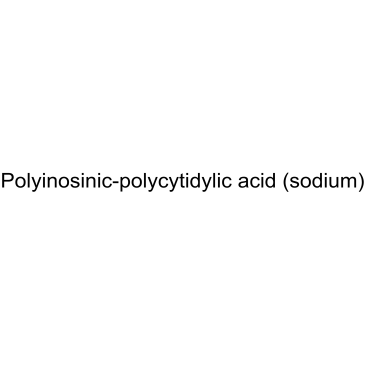42424-50-0
| Name | polyinosinic-polycytidylic acid sodium salt |
|---|---|
| Synonyms | MFCD00131984 |
| Description | Polyinosinic-polycytidylic acid sodium (Poly(I:C) sodium) is a synthetic analog of double-stranded RNA and an agonist of toll-like receptor 3 (TLR3) and retinoic acid inducible gene I (RIG-I)-like receptors (RIG-I and MDA5). Polyinosinic-polycytidylic acid sodium can be used as a vaccine adjuvant to enhance innate and adaptive immune responses, and to alter the tumor microenvironment. Polyinosinic-polycytidylic acid sodium can directly trigger cancer cells to undergo apoptosis[1][2]. |
|---|---|
| Related Catalog | |
| Target |
TLR3[2], RIG-I[2], MDA5[2], apoptosis[2] |
| In Vitro | Polyinosinic-polycytidylic acid (20 ng/mL; 24 hours; WM793, WM278, WM239A, WM9 and 1205Lu cells) treatment strongly reduces viability from 100% in controls to 20%–50% within 24 hours[1]. Polyinosinic-polycytidylic acid (200 ng/mL; 24 hours; 1205Lu cells) treatment induces apoptosis in 1205Lu cells[1]. Polyinosinic-polycytidylic acid (3 ng/mL; 24 hours; 1205Lu cells) treatment induces IFN-β expression in melanoma cells. Silencing of RIG-I and MDA-5 confirmed that induction of IFN-β by Polyinosinic-polycytidylic acid required RIG-I and MDA-5, respectively, and that required IPS-1[1]. Polyinosinic-polycytidylic acid (5 ng/mL; 24 hours; 1205Lu cells) treatment reveals active subunits of caspase-9 and caspase-8 in melanoma cells[1]. Cell Viability Assay[1] Cell Line: WM793, WM278, WM239A, WM9 and 1205Lu cells Concentration: 20 ng/mL Incubation Time: 24 hours Result: Strongly reduced viability from 100% in controls to 20%–50% within 24 hours. Apoptosis Analysis[1] Cell Line: 1205Lu cells Concentration: 200 ng/mL Incubation Time: 24 hours Result: Induced apoptosis in 1205Lu cells. RT-PCR[1] Cell Line: 1205Lu cells Concentration: 3 ng/mL Incubation Time: 24 hours Result: Induced IFN-β expression in melanoma cells. Western Blot Analysis[1] Cell Line: 1205Lu cells Concentration: 5 ng/mL Incubation Time: 24 hours Result: Revealed active subunits of caspase-9 and caspase-8 in melanoma cells. |
| In Vivo | Polyinosinic-polycytidylic acid treatment inhibits tumor growth in NOD/SCID immunodeficient mice injected with 1205Lu cells. The level of human DNA is 50% lower in mice treated with Polyinosinic-polycytidylic acid[1]. |
| References |
| Molecular Formula | C19H27N7NaO16P2 |
|---|---|
| Molecular Weight | 694.4 |
| Storage condition | −20°C |
| Water Solubility | H2O: soluble10mg/mL |
| Personal Protective Equipment | Eyeshields;Gloves;type N95 (US);type P1 (EN143) respirator filter |
|---|---|
| Hazard Codes | Xi |
| Safety Phrases | 22-24/25 |
| RIDADR | NONH for all modes of transport |
| WGK Germany | 3 |
| RTECS | TR0175000 |
